Evaluation of Executive Performance and Remuneration for Westpac Bank
VerifiedAdded on 2021/06/17
|20
|3912
|73
Report
AI Summary
This report conducts a literature review on the evaluation of executive performance and remuneration for publicly listed companies in Australia, using Westpac as a case study. The report analyzes Westpac's remuneration committee, allocation of executive remuneration (fixed, short-term, and long-term incentives), the mix of financial (earnings per share, return on investment, and return on equity) and non-financial performance measures (balanced scorecard approach), changes in executive remuneration reporting, and company performance versus executive pay. The analysis includes a critical evaluation of the remuneration methods used, along with recommendations for improving Westpac's remuneration reporting procedures. The report highlights key performance indicators and their impact on executive compensation, providing a comprehensive overview of Westpac's approach to aligning executive incentives with company performance and shareholder interests.
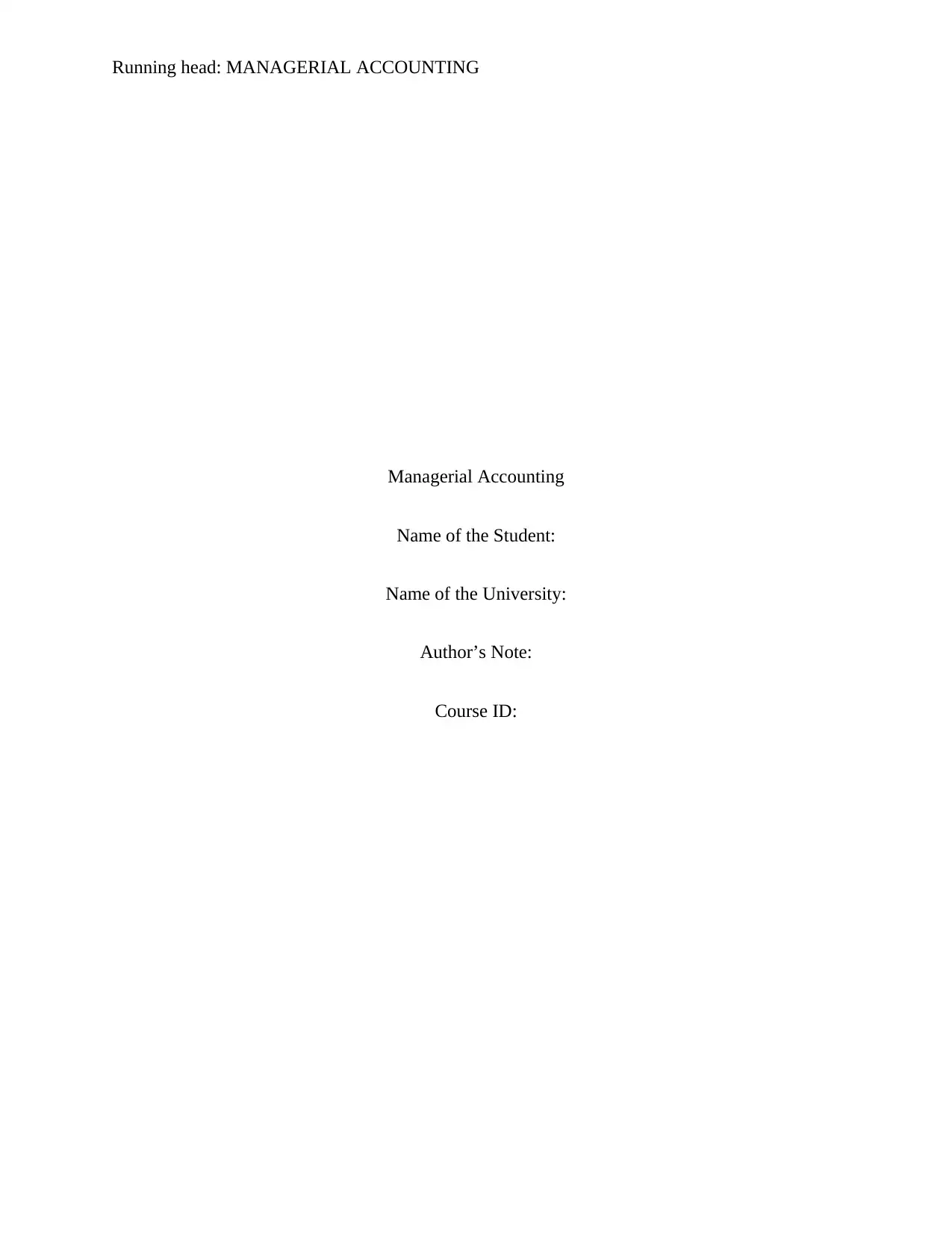
Running head: MANAGERIAL ACCOUNTING
Managerial Accounting
Name of the Student:
Name of the University:
Author’s Note:
Course ID:
Managerial Accounting
Name of the Student:
Name of the University:
Author’s Note:
Course ID:
Paraphrase This Document
Need a fresh take? Get an instant paraphrase of this document with our AI Paraphraser
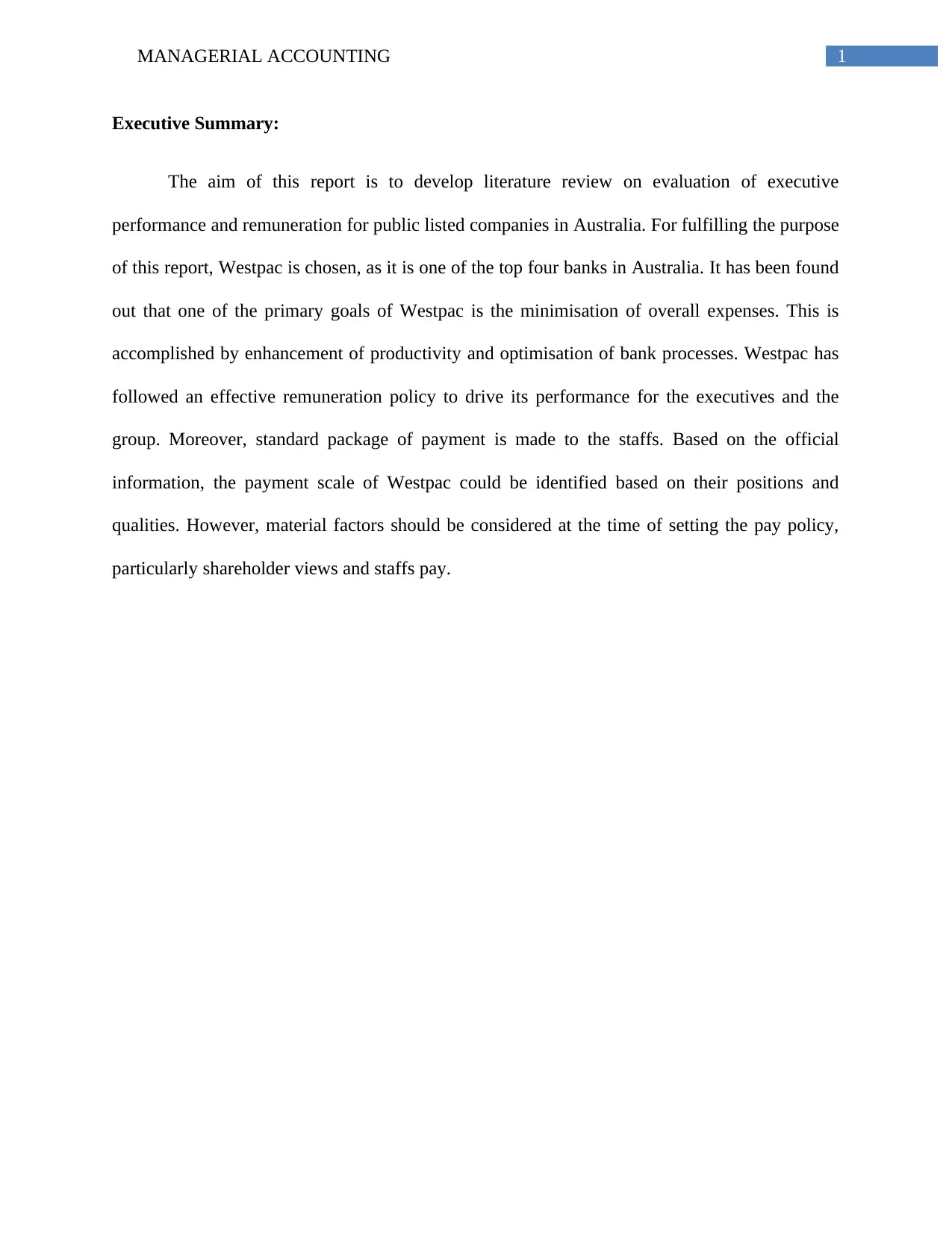
1MANAGERIAL ACCOUNTING
Executive Summary:
The aim of this report is to develop literature review on evaluation of executive
performance and remuneration for public listed companies in Australia. For fulfilling the purpose
of this report, Westpac is chosen, as it is one of the top four banks in Australia. It has been found
out that one of the primary goals of Westpac is the minimisation of overall expenses. This is
accomplished by enhancement of productivity and optimisation of bank processes. Westpac has
followed an effective remuneration policy to drive its performance for the executives and the
group. Moreover, standard package of payment is made to the staffs. Based on the official
information, the payment scale of Westpac could be identified based on their positions and
qualities. However, material factors should be considered at the time of setting the pay policy,
particularly shareholder views and staffs pay.
Executive Summary:
The aim of this report is to develop literature review on evaluation of executive
performance and remuneration for public listed companies in Australia. For fulfilling the purpose
of this report, Westpac is chosen, as it is one of the top four banks in Australia. It has been found
out that one of the primary goals of Westpac is the minimisation of overall expenses. This is
accomplished by enhancement of productivity and optimisation of bank processes. Westpac has
followed an effective remuneration policy to drive its performance for the executives and the
group. Moreover, standard package of payment is made to the staffs. Based on the official
information, the payment scale of Westpac could be identified based on their positions and
qualities. However, material factors should be considered at the time of setting the pay policy,
particularly shareholder views and staffs pay.
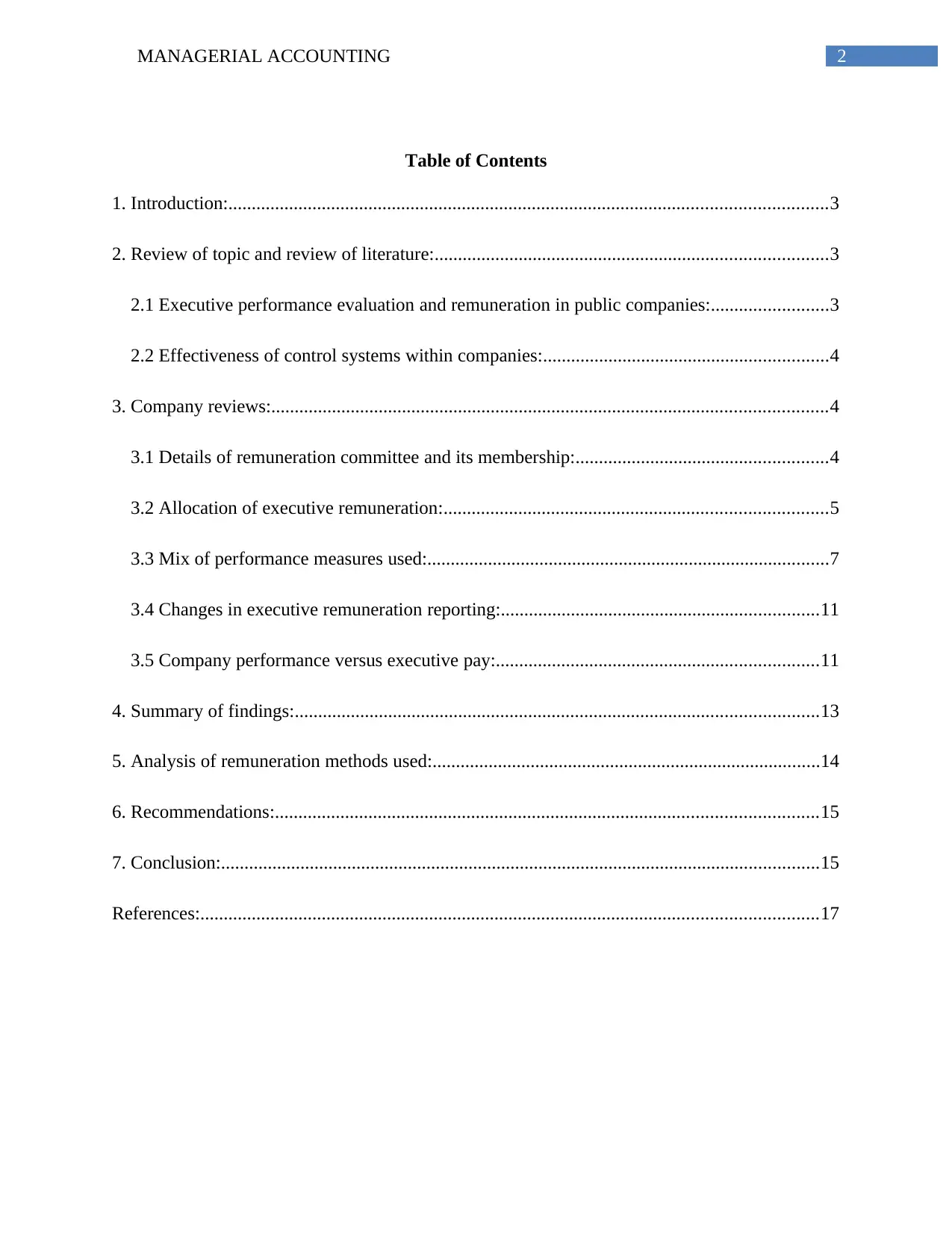
2MANAGERIAL ACCOUNTING
Table of Contents
1. Introduction:................................................................................................................................3
2. Review of topic and review of literature:....................................................................................3
2.1 Executive performance evaluation and remuneration in public companies:.........................3
2.2 Effectiveness of control systems within companies:.............................................................4
3. Company reviews:.......................................................................................................................4
3.1 Details of remuneration committee and its membership:......................................................4
3.2 Allocation of executive remuneration:..................................................................................5
3.3 Mix of performance measures used:......................................................................................7
3.4 Changes in executive remuneration reporting:....................................................................11
3.5 Company performance versus executive pay:.....................................................................11
4. Summary of findings:................................................................................................................13
5. Analysis of remuneration methods used:...................................................................................14
6. Recommendations:....................................................................................................................15
7. Conclusion:................................................................................................................................15
References:....................................................................................................................................17
Table of Contents
1. Introduction:................................................................................................................................3
2. Review of topic and review of literature:....................................................................................3
2.1 Executive performance evaluation and remuneration in public companies:.........................3
2.2 Effectiveness of control systems within companies:.............................................................4
3. Company reviews:.......................................................................................................................4
3.1 Details of remuneration committee and its membership:......................................................4
3.2 Allocation of executive remuneration:..................................................................................5
3.3 Mix of performance measures used:......................................................................................7
3.4 Changes in executive remuneration reporting:....................................................................11
3.5 Company performance versus executive pay:.....................................................................11
4. Summary of findings:................................................................................................................13
5. Analysis of remuneration methods used:...................................................................................14
6. Recommendations:....................................................................................................................15
7. Conclusion:................................................................................................................................15
References:....................................................................................................................................17
⊘ This is a preview!⊘
Do you want full access?
Subscribe today to unlock all pages.

Trusted by 1+ million students worldwide
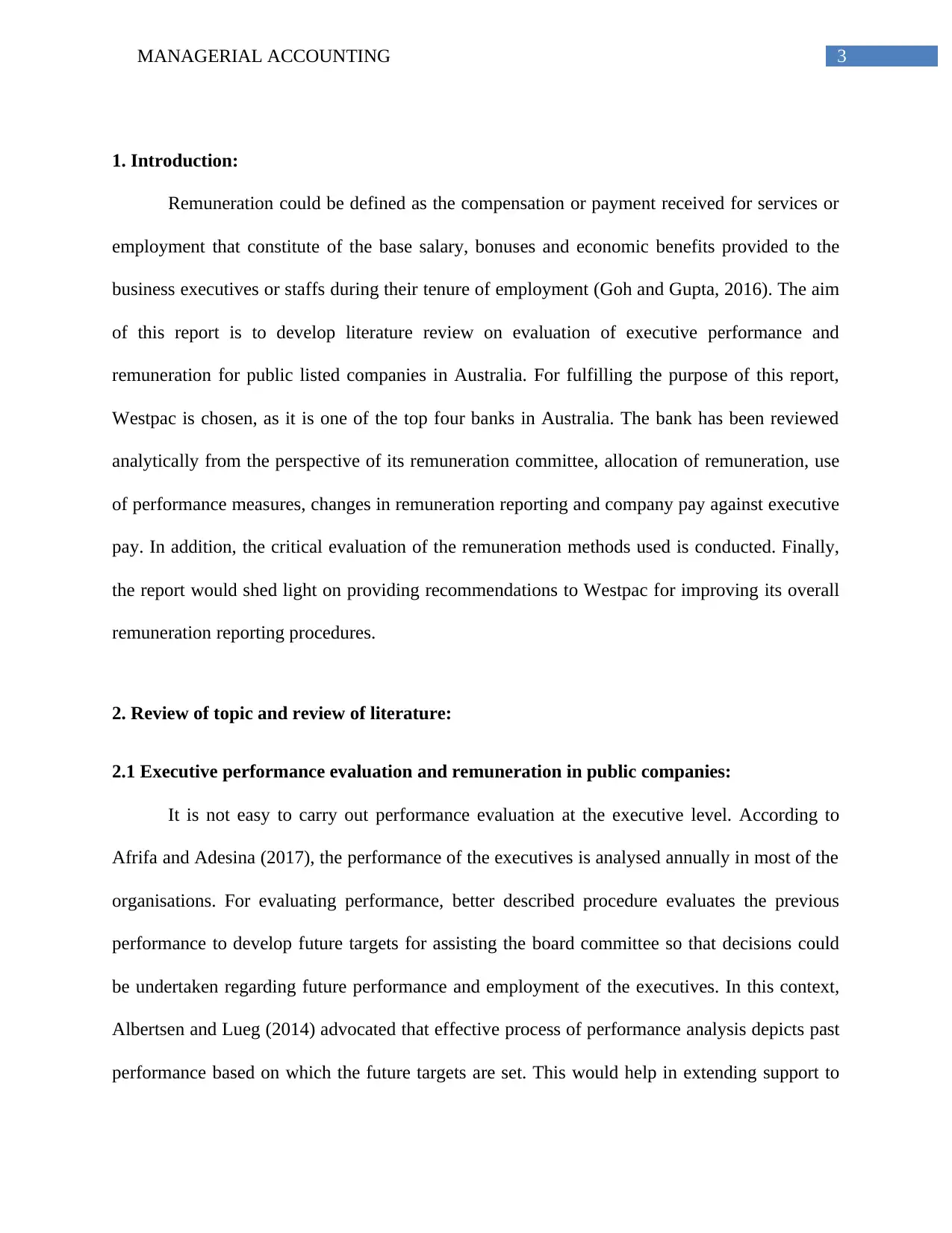
3MANAGERIAL ACCOUNTING
1. Introduction:
Remuneration could be defined as the compensation or payment received for services or
employment that constitute of the base salary, bonuses and economic benefits provided to the
business executives or staffs during their tenure of employment (Goh and Gupta, 2016). The aim
of this report is to develop literature review on evaluation of executive performance and
remuneration for public listed companies in Australia. For fulfilling the purpose of this report,
Westpac is chosen, as it is one of the top four banks in Australia. The bank has been reviewed
analytically from the perspective of its remuneration committee, allocation of remuneration, use
of performance measures, changes in remuneration reporting and company pay against executive
pay. In addition, the critical evaluation of the remuneration methods used is conducted. Finally,
the report would shed light on providing recommendations to Westpac for improving its overall
remuneration reporting procedures.
2. Review of topic and review of literature:
2.1 Executive performance evaluation and remuneration in public companies:
It is not easy to carry out performance evaluation at the executive level. According to
Afrifa and Adesina (2017), the performance of the executives is analysed annually in most of the
organisations. For evaluating performance, better described procedure evaluates the previous
performance to develop future targets for assisting the board committee so that decisions could
be undertaken regarding future performance and employment of the executives. In this context,
Albertsen and Lueg (2014) advocated that effective process of performance analysis depicts past
performance based on which the future targets are set. This would help in extending support to
1. Introduction:
Remuneration could be defined as the compensation or payment received for services or
employment that constitute of the base salary, bonuses and economic benefits provided to the
business executives or staffs during their tenure of employment (Goh and Gupta, 2016). The aim
of this report is to develop literature review on evaluation of executive performance and
remuneration for public listed companies in Australia. For fulfilling the purpose of this report,
Westpac is chosen, as it is one of the top four banks in Australia. The bank has been reviewed
analytically from the perspective of its remuneration committee, allocation of remuneration, use
of performance measures, changes in remuneration reporting and company pay against executive
pay. In addition, the critical evaluation of the remuneration methods used is conducted. Finally,
the report would shed light on providing recommendations to Westpac for improving its overall
remuneration reporting procedures.
2. Review of topic and review of literature:
2.1 Executive performance evaluation and remuneration in public companies:
It is not easy to carry out performance evaluation at the executive level. According to
Afrifa and Adesina (2017), the performance of the executives is analysed annually in most of the
organisations. For evaluating performance, better described procedure evaluates the previous
performance to develop future targets for assisting the board committee so that decisions could
be undertaken regarding future performance and employment of the executives. In this context,
Albertsen and Lueg (2014) advocated that effective process of performance analysis depicts past
performance based on which the future targets are set. This would help in extending support to
Paraphrase This Document
Need a fresh take? Get an instant paraphrase of this document with our AI Paraphraser

4MANAGERIAL ACCOUNTING
the remuneration committee for undertaking suitable decisions to set effective strategic goals,
future compensation and employment.
2.2 Effectiveness of control systems within companies:
Control systems are extremely significant for the business organisations after developing
strategic plans so that the business objectives could be accomplished. In addition, with the help
of control systems, an organisation could fulfil its objectives by adhering to the internal, legal
and regulatory standards. One of the significant factors related to the effectiveness of control
systems is the quality of information received (Chang, Yu and Hung, 2015). However, there
needs to be accuracy and updated information within the control system. In addition, with the
help of internal controls, data could be obtained timely; however, there needs to be processing of
various kinds of financial information leading to delays. Hence, control systems are significant in
maintaining executive performance and reward systems (Provasi and Riva, 2016).
3. Company reviews:
3.1 Details of remuneration committee and its membership:
It could be observed from the annual report of Westpac in 2017, that there are currently
four members in the remuneration committee of the bank and they are independent, non-
executive directors. The remuneration committee is entitled to review and recommend the board
in relation to the remuneration policy of Westpac along with its evaluating its effectiveness and
adherence to the prudential standards (Westpac.com.au, 2018). The committee is accountable to
review and recommend the individual remuneration levels of the key personnel of the bank. The
committee membership and its chairperson would be ascertained as from time to time on the part
of the board.
the remuneration committee for undertaking suitable decisions to set effective strategic goals,
future compensation and employment.
2.2 Effectiveness of control systems within companies:
Control systems are extremely significant for the business organisations after developing
strategic plans so that the business objectives could be accomplished. In addition, with the help
of control systems, an organisation could fulfil its objectives by adhering to the internal, legal
and regulatory standards. One of the significant factors related to the effectiveness of control
systems is the quality of information received (Chang, Yu and Hung, 2015). However, there
needs to be accuracy and updated information within the control system. In addition, with the
help of internal controls, data could be obtained timely; however, there needs to be processing of
various kinds of financial information leading to delays. Hence, control systems are significant in
maintaining executive performance and reward systems (Provasi and Riva, 2016).
3. Company reviews:
3.1 Details of remuneration committee and its membership:
It could be observed from the annual report of Westpac in 2017, that there are currently
four members in the remuneration committee of the bank and they are independent, non-
executive directors. The remuneration committee is entitled to review and recommend the board
in relation to the remuneration policy of Westpac along with its evaluating its effectiveness and
adherence to the prudential standards (Westpac.com.au, 2018). The committee is accountable to
review and recommend the individual remuneration levels of the key personnel of the bank. The
committee membership and its chairperson would be ascertained as from time to time on the part
of the board.
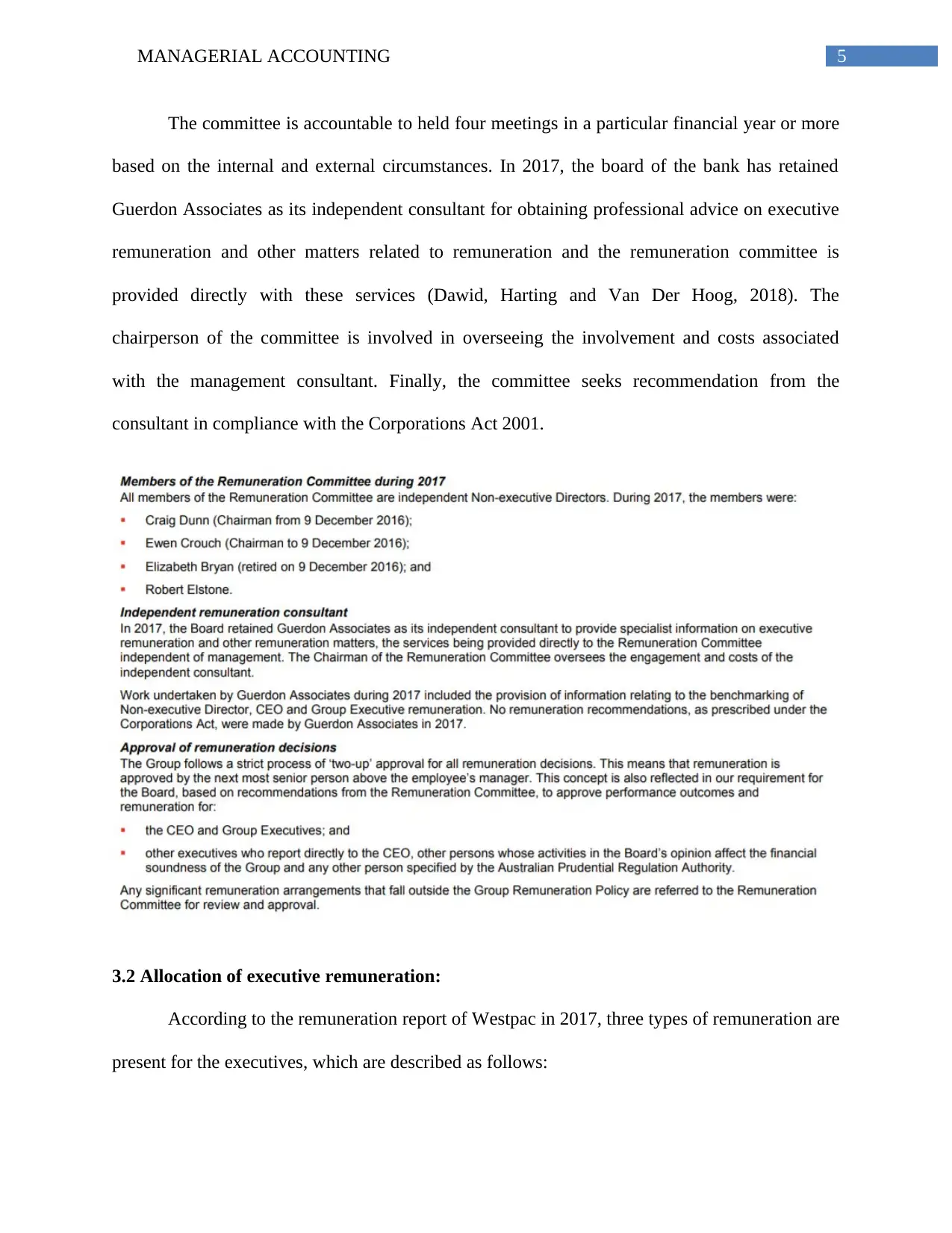
5MANAGERIAL ACCOUNTING
The committee is accountable to held four meetings in a particular financial year or more
based on the internal and external circumstances. In 2017, the board of the bank has retained
Guerdon Associates as its independent consultant for obtaining professional advice on executive
remuneration and other matters related to remuneration and the remuneration committee is
provided directly with these services (Dawid, Harting and Van Der Hoog, 2018). The
chairperson of the committee is involved in overseeing the involvement and costs associated
with the management consultant. Finally, the committee seeks recommendation from the
consultant in compliance with the Corporations Act 2001.
3.2 Allocation of executive remuneration:
According to the remuneration report of Westpac in 2017, three types of remuneration are
present for the executives, which are described as follows:
The committee is accountable to held four meetings in a particular financial year or more
based on the internal and external circumstances. In 2017, the board of the bank has retained
Guerdon Associates as its independent consultant for obtaining professional advice on executive
remuneration and other matters related to remuneration and the remuneration committee is
provided directly with these services (Dawid, Harting and Van Der Hoog, 2018). The
chairperson of the committee is involved in overseeing the involvement and costs associated
with the management consultant. Finally, the committee seeks recommendation from the
consultant in compliance with the Corporations Act 2001.
3.2 Allocation of executive remuneration:
According to the remuneration report of Westpac in 2017, three types of remuneration are
present for the executives, which are described as follows:
⊘ This is a preview!⊘
Do you want full access?
Subscribe today to unlock all pages.

Trusted by 1+ million students worldwide
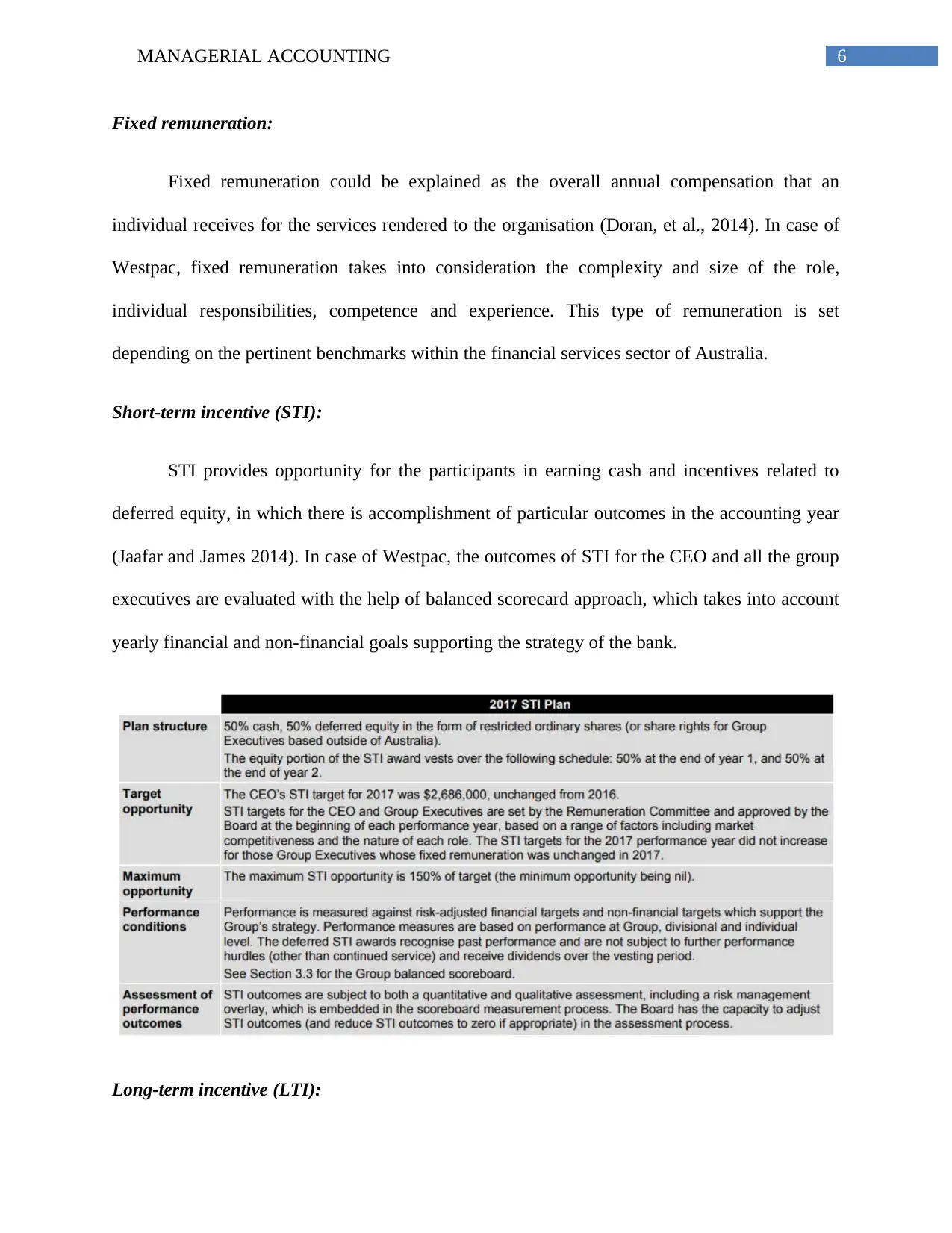
6MANAGERIAL ACCOUNTING
Fixed remuneration:
Fixed remuneration could be explained as the overall annual compensation that an
individual receives for the services rendered to the organisation (Doran, et al., 2014). In case of
Westpac, fixed remuneration takes into consideration the complexity and size of the role,
individual responsibilities, competence and experience. This type of remuneration is set
depending on the pertinent benchmarks within the financial services sector of Australia.
Short-term incentive (STI):
STI provides opportunity for the participants in earning cash and incentives related to
deferred equity, in which there is accomplishment of particular outcomes in the accounting year
(Jaafar and James 2014). In case of Westpac, the outcomes of STI for the CEO and all the group
executives are evaluated with the help of balanced scorecard approach, which takes into account
yearly financial and non-financial goals supporting the strategy of the bank.
Long-term incentive (LTI):
Fixed remuneration:
Fixed remuneration could be explained as the overall annual compensation that an
individual receives for the services rendered to the organisation (Doran, et al., 2014). In case of
Westpac, fixed remuneration takes into consideration the complexity and size of the role,
individual responsibilities, competence and experience. This type of remuneration is set
depending on the pertinent benchmarks within the financial services sector of Australia.
Short-term incentive (STI):
STI provides opportunity for the participants in earning cash and incentives related to
deferred equity, in which there is accomplishment of particular outcomes in the accounting year
(Jaafar and James 2014). In case of Westpac, the outcomes of STI for the CEO and all the group
executives are evaluated with the help of balanced scorecard approach, which takes into account
yearly financial and non-financial goals supporting the strategy of the bank.
Long-term incentive (LTI):
Paraphrase This Document
Need a fresh take? Get an instant paraphrase of this document with our AI Paraphraser
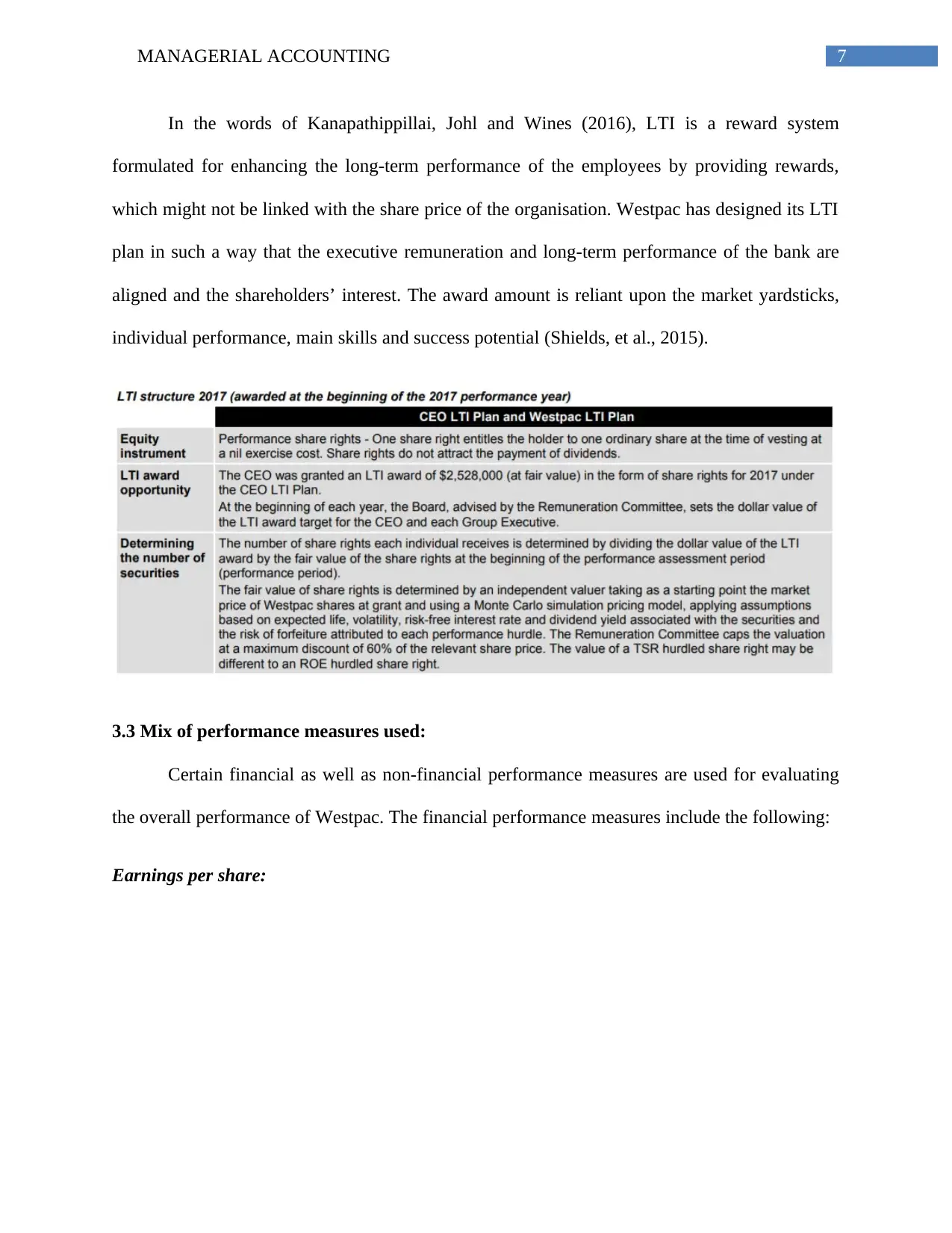
7MANAGERIAL ACCOUNTING
In the words of Kanapathippillai, Johl and Wines (2016), LTI is a reward system
formulated for enhancing the long-term performance of the employees by providing rewards,
which might not be linked with the share price of the organisation. Westpac has designed its LTI
plan in such a way that the executive remuneration and long-term performance of the bank are
aligned and the shareholders’ interest. The award amount is reliant upon the market yardsticks,
individual performance, main skills and success potential (Shields, et al., 2015).
3.3 Mix of performance measures used:
Certain financial as well as non-financial performance measures are used for evaluating
the overall performance of Westpac. The financial performance measures include the following:
Earnings per share:
In the words of Kanapathippillai, Johl and Wines (2016), LTI is a reward system
formulated for enhancing the long-term performance of the employees by providing rewards,
which might not be linked with the share price of the organisation. Westpac has designed its LTI
plan in such a way that the executive remuneration and long-term performance of the bank are
aligned and the shareholders’ interest. The award amount is reliant upon the market yardsticks,
individual performance, main skills and success potential (Shields, et al., 2015).
3.3 Mix of performance measures used:
Certain financial as well as non-financial performance measures are used for evaluating
the overall performance of Westpac. The financial performance measures include the following:
Earnings per share:

8MANAGERIAL ACCOUNTING
2017 2016 2015
2.10
2.15
2.20
2.25
2.30
2.35
2.40
2.45
2.50
2.55
2.60
2.38
2.25
2.55
Earning Price Per Share
Westpac
Based on the above figure, it could be identified that the earnings per share of Westpac
have fallen from $2.55 in 2015 to $2.25 in 2016; however, the increase is significant to $2.38 in
2017. With the help of earnings per share, it is possible to identify the ability of an organisation
in generating profits for its common stockholders (Khalid and Rehman, 2014). In case of
Wesfarmers, due to the generation of higher net income in 2017, it has managed to provide
adequate returns to the shareholders.
Return on investment:
2017 2016 2015
0.82%
0.84%
0.86%
0.88%
0.90%
0.92%
0.94%
0.96%
0.98%
1.00%
0.94%
0.89%
0.99%
Return On Investment
Westpac
2017 2016 2015
2.10
2.15
2.20
2.25
2.30
2.35
2.40
2.45
2.50
2.55
2.60
2.38
2.25
2.55
Earning Price Per Share
Westpac
Based on the above figure, it could be identified that the earnings per share of Westpac
have fallen from $2.55 in 2015 to $2.25 in 2016; however, the increase is significant to $2.38 in
2017. With the help of earnings per share, it is possible to identify the ability of an organisation
in generating profits for its common stockholders (Khalid and Rehman, 2014). In case of
Wesfarmers, due to the generation of higher net income in 2017, it has managed to provide
adequate returns to the shareholders.
Return on investment:
2017 2016 2015
0.82%
0.84%
0.86%
0.88%
0.90%
0.92%
0.94%
0.96%
0.98%
1.00%
0.94%
0.89%
0.99%
Return On Investment
Westpac
⊘ This is a preview!⊘
Do you want full access?
Subscribe today to unlock all pages.

Trusted by 1+ million students worldwide
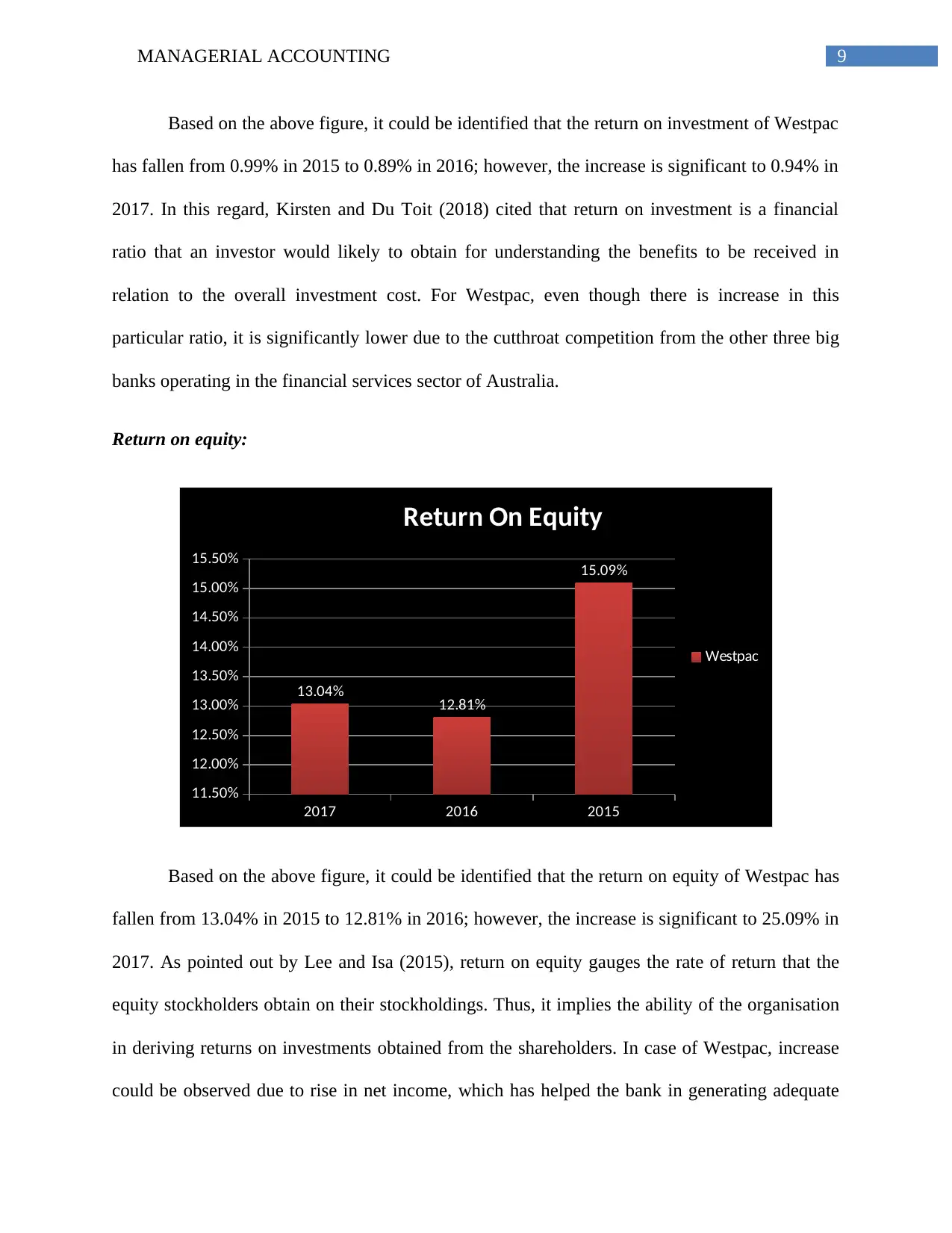
9MANAGERIAL ACCOUNTING
Based on the above figure, it could be identified that the return on investment of Westpac
has fallen from 0.99% in 2015 to 0.89% in 2016; however, the increase is significant to 0.94% in
2017. In this regard, Kirsten and Du Toit (2018) cited that return on investment is a financial
ratio that an investor would likely to obtain for understanding the benefits to be received in
relation to the overall investment cost. For Westpac, even though there is increase in this
particular ratio, it is significantly lower due to the cutthroat competition from the other three big
banks operating in the financial services sector of Australia.
Return on equity:
2017 2016 2015
11.50%
12.00%
12.50%
13.00%
13.50%
14.00%
14.50%
15.00%
15.50%
13.04% 12.81%
15.09%
Return On Equity
Westpac
Based on the above figure, it could be identified that the return on equity of Westpac has
fallen from 13.04% in 2015 to 12.81% in 2016; however, the increase is significant to 25.09% in
2017. As pointed out by Lee and Isa (2015), return on equity gauges the rate of return that the
equity stockholders obtain on their stockholdings. Thus, it implies the ability of the organisation
in deriving returns on investments obtained from the shareholders. In case of Westpac, increase
could be observed due to rise in net income, which has helped the bank in generating adequate
Based on the above figure, it could be identified that the return on investment of Westpac
has fallen from 0.99% in 2015 to 0.89% in 2016; however, the increase is significant to 0.94% in
2017. In this regard, Kirsten and Du Toit (2018) cited that return on investment is a financial
ratio that an investor would likely to obtain for understanding the benefits to be received in
relation to the overall investment cost. For Westpac, even though there is increase in this
particular ratio, it is significantly lower due to the cutthroat competition from the other three big
banks operating in the financial services sector of Australia.
Return on equity:
2017 2016 2015
11.50%
12.00%
12.50%
13.00%
13.50%
14.00%
14.50%
15.00%
15.50%
13.04% 12.81%
15.09%
Return On Equity
Westpac
Based on the above figure, it could be identified that the return on equity of Westpac has
fallen from 13.04% in 2015 to 12.81% in 2016; however, the increase is significant to 25.09% in
2017. As pointed out by Lee and Isa (2015), return on equity gauges the rate of return that the
equity stockholders obtain on their stockholdings. Thus, it implies the ability of the organisation
in deriving returns on investments obtained from the shareholders. In case of Westpac, increase
could be observed due to rise in net income, which has helped the bank in generating adequate
Paraphrase This Document
Need a fresh take? Get an instant paraphrase of this document with our AI Paraphraser
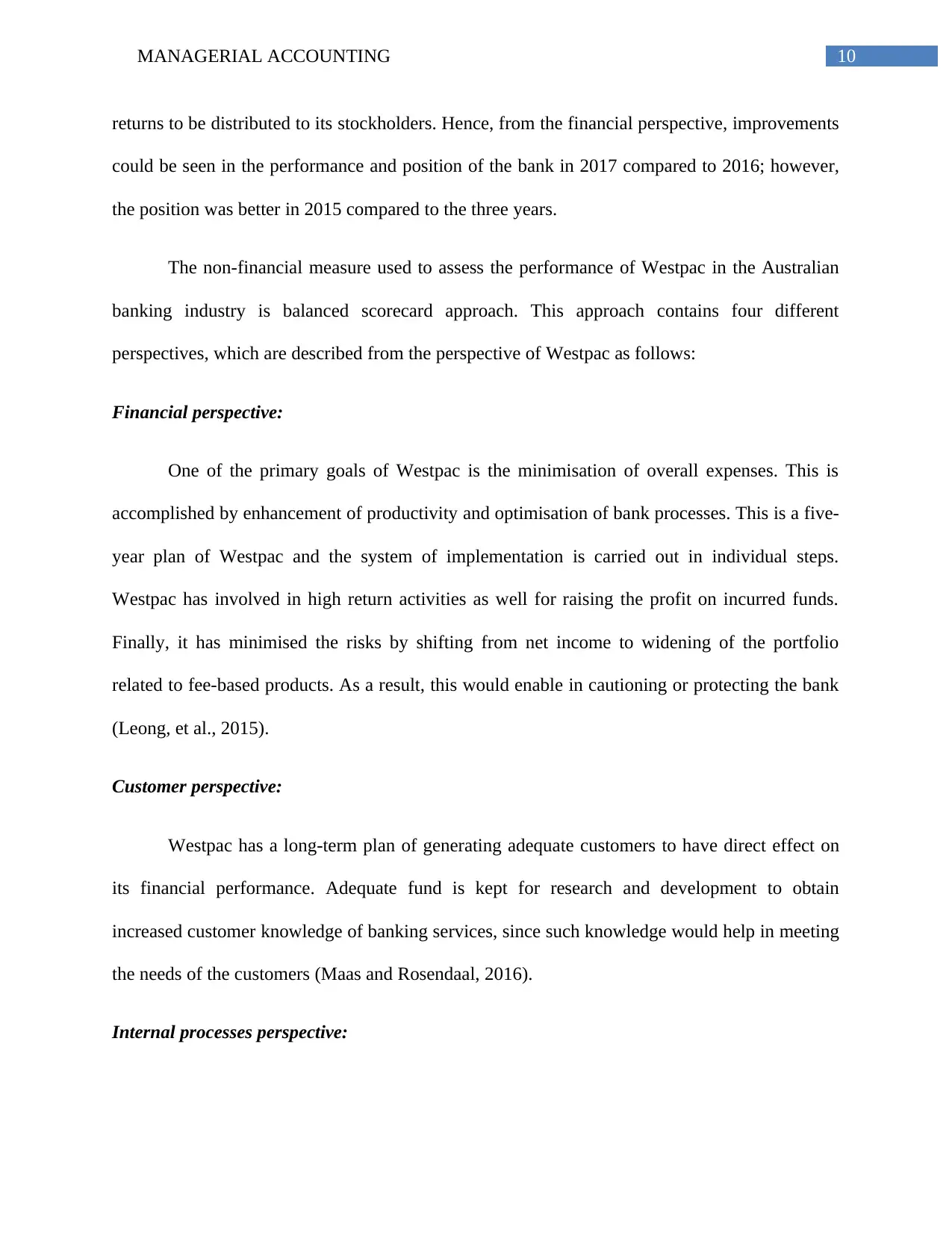
10MANAGERIAL ACCOUNTING
returns to be distributed to its stockholders. Hence, from the financial perspective, improvements
could be seen in the performance and position of the bank in 2017 compared to 2016; however,
the position was better in 2015 compared to the three years.
The non-financial measure used to assess the performance of Westpac in the Australian
banking industry is balanced scorecard approach. This approach contains four different
perspectives, which are described from the perspective of Westpac as follows:
Financial perspective:
One of the primary goals of Westpac is the minimisation of overall expenses. This is
accomplished by enhancement of productivity and optimisation of bank processes. This is a five-
year plan of Westpac and the system of implementation is carried out in individual steps.
Westpac has involved in high return activities as well for raising the profit on incurred funds.
Finally, it has minimised the risks by shifting from net income to widening of the portfolio
related to fee-based products. As a result, this would enable in cautioning or protecting the bank
(Leong, et al., 2015).
Customer perspective:
Westpac has a long-term plan of generating adequate customers to have direct effect on
its financial performance. Adequate fund is kept for research and development to obtain
increased customer knowledge of banking services, since such knowledge would help in meeting
the needs of the customers (Maas and Rosendaal, 2016).
Internal processes perspective:
returns to be distributed to its stockholders. Hence, from the financial perspective, improvements
could be seen in the performance and position of the bank in 2017 compared to 2016; however,
the position was better in 2015 compared to the three years.
The non-financial measure used to assess the performance of Westpac in the Australian
banking industry is balanced scorecard approach. This approach contains four different
perspectives, which are described from the perspective of Westpac as follows:
Financial perspective:
One of the primary goals of Westpac is the minimisation of overall expenses. This is
accomplished by enhancement of productivity and optimisation of bank processes. This is a five-
year plan of Westpac and the system of implementation is carried out in individual steps.
Westpac has involved in high return activities as well for raising the profit on incurred funds.
Finally, it has minimised the risks by shifting from net income to widening of the portfolio
related to fee-based products. As a result, this would enable in cautioning or protecting the bank
(Leong, et al., 2015).
Customer perspective:
Westpac has a long-term plan of generating adequate customers to have direct effect on
its financial performance. Adequate fund is kept for research and development to obtain
increased customer knowledge of banking services, since such knowledge would help in meeting
the needs of the customers (Maas and Rosendaal, 2016).
Internal processes perspective:
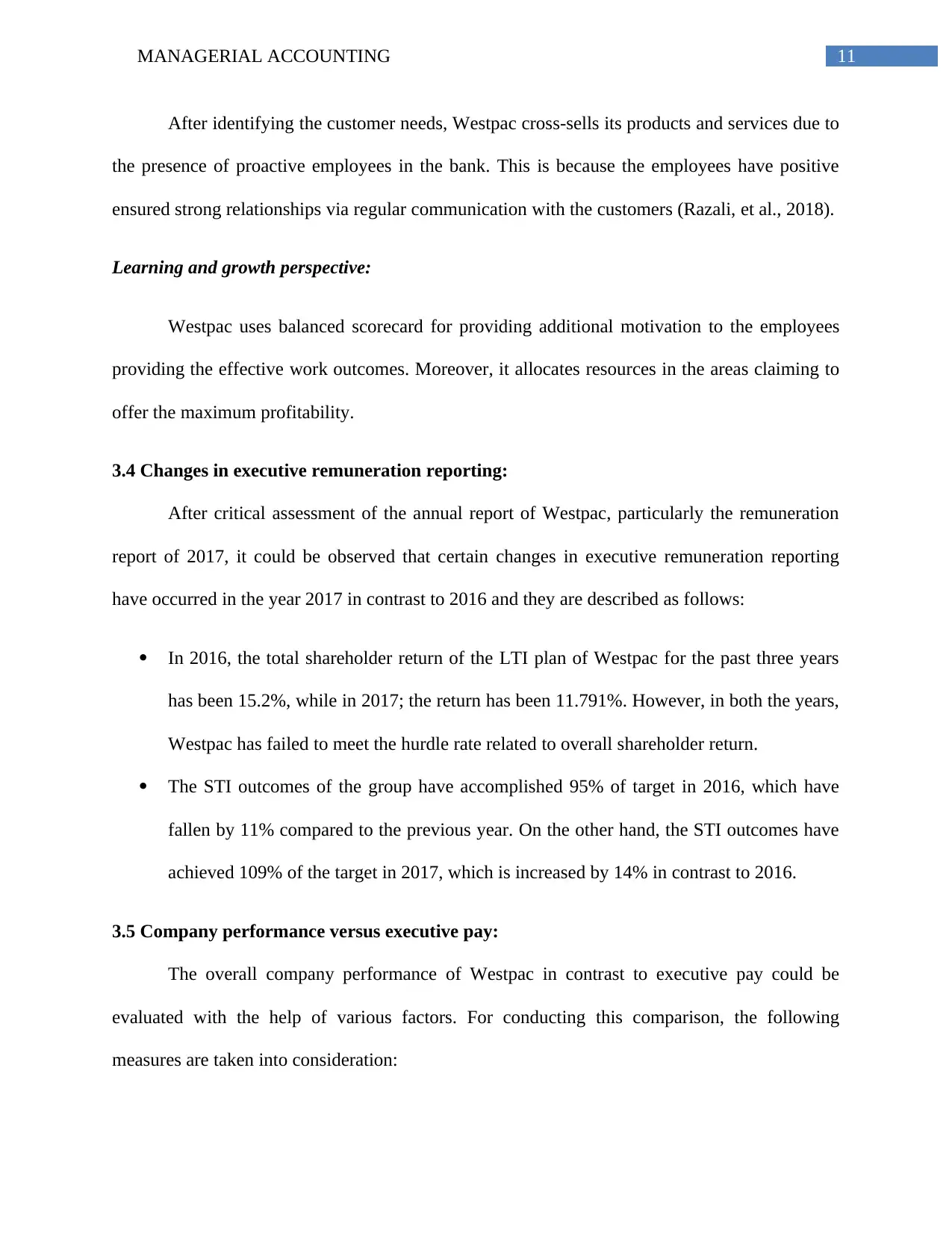
11MANAGERIAL ACCOUNTING
After identifying the customer needs, Westpac cross-sells its products and services due to
the presence of proactive employees in the bank. This is because the employees have positive
ensured strong relationships via regular communication with the customers (Razali, et al., 2018).
Learning and growth perspective:
Westpac uses balanced scorecard for providing additional motivation to the employees
providing the effective work outcomes. Moreover, it allocates resources in the areas claiming to
offer the maximum profitability.
3.4 Changes in executive remuneration reporting:
After critical assessment of the annual report of Westpac, particularly the remuneration
report of 2017, it could be observed that certain changes in executive remuneration reporting
have occurred in the year 2017 in contrast to 2016 and they are described as follows:
In 2016, the total shareholder return of the LTI plan of Westpac for the past three years
has been 15.2%, while in 2017; the return has been 11.791%. However, in both the years,
Westpac has failed to meet the hurdle rate related to overall shareholder return.
The STI outcomes of the group have accomplished 95% of target in 2016, which have
fallen by 11% compared to the previous year. On the other hand, the STI outcomes have
achieved 109% of the target in 2017, which is increased by 14% in contrast to 2016.
3.5 Company performance versus executive pay:
The overall company performance of Westpac in contrast to executive pay could be
evaluated with the help of various factors. For conducting this comparison, the following
measures are taken into consideration:
After identifying the customer needs, Westpac cross-sells its products and services due to
the presence of proactive employees in the bank. This is because the employees have positive
ensured strong relationships via regular communication with the customers (Razali, et al., 2018).
Learning and growth perspective:
Westpac uses balanced scorecard for providing additional motivation to the employees
providing the effective work outcomes. Moreover, it allocates resources in the areas claiming to
offer the maximum profitability.
3.4 Changes in executive remuneration reporting:
After critical assessment of the annual report of Westpac, particularly the remuneration
report of 2017, it could be observed that certain changes in executive remuneration reporting
have occurred in the year 2017 in contrast to 2016 and they are described as follows:
In 2016, the total shareholder return of the LTI plan of Westpac for the past three years
has been 15.2%, while in 2017; the return has been 11.791%. However, in both the years,
Westpac has failed to meet the hurdle rate related to overall shareholder return.
The STI outcomes of the group have accomplished 95% of target in 2016, which have
fallen by 11% compared to the previous year. On the other hand, the STI outcomes have
achieved 109% of the target in 2017, which is increased by 14% in contrast to 2016.
3.5 Company performance versus executive pay:
The overall company performance of Westpac in contrast to executive pay could be
evaluated with the help of various factors. For conducting this comparison, the following
measures are taken into consideration:
⊘ This is a preview!⊘
Do you want full access?
Subscribe today to unlock all pages.

Trusted by 1+ million students worldwide
1 out of 20
Related Documents
Your All-in-One AI-Powered Toolkit for Academic Success.
+13062052269
info@desklib.com
Available 24*7 on WhatsApp / Email
![[object Object]](/_next/static/media/star-bottom.7253800d.svg)
Unlock your academic potential
Copyright © 2020–2025 A2Z Services. All Rights Reserved. Developed and managed by ZUCOL.





